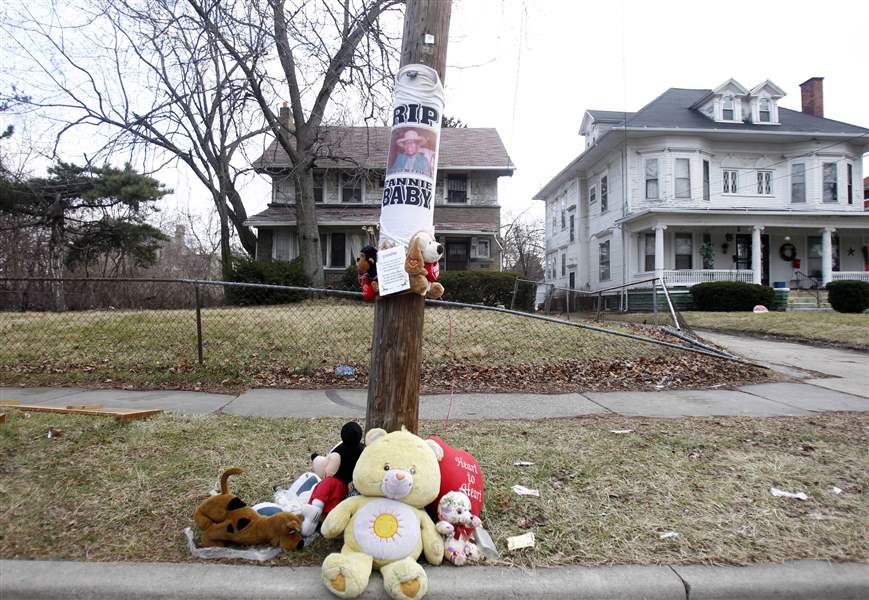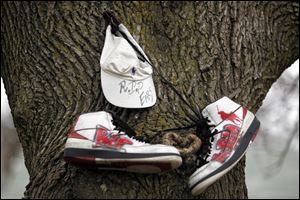
Mourners of Toledo's slain share pain publicly
2/10/2012
A memorial for Fannie Mae Smith is on a utility pole in front of 2264 Fulton St. Ms. Smith, 81, was shot and killed while sitting in the sunroom in the front of her home early in the morning on Jan. 3.
THE BLADE/AMY E. VOIGT
Buy This Image

A memorial for Fannie Mae Smith is on a utility pole in front of 2264 Fulton St. Ms. Smith, 81, was shot and killed while sitting in the sunroom in the front of her home early in the morning on Jan. 3.
Joseph Fleming pushed up the cuffs on his black zip-up jacket and made fists to show the tattoos on the tops of his hands.
"R.I.P. Man" on the right, "Man" on the left.
On a chilly, gray February afternoon in Toledo's central city, Mr. Fleming, 22, and his friends stopped in front of 349 Islington St., where their friend, Marquise "Man Man" Chandler, was shot and killed in April, 2010.
A T-shirt with a photo of Chandler praying is wrapped around a tree in front of the now boarded-up house. It's one of dozens of public memorials to the city's slain residents.
It seems nearly impossible to travel about the city without seeing reminders of friends, family, or complete strangers whose blood has spilled on Toledo's streets.
On street corners, in back alleys, at the ends of driveways are memorials erected in an attempt to immortalize the dead.
Some people will walk or drive by them every day until the memorials -- usually surrounded by stuffed animals, candles, empty beer and liquor bottles, and photos -- blend in as part of the natural scenery.
Others, such as the group of women who paused in front of a memorial to Fannie Mae Smith on Fulton Street on a recent afternoon, might be curious a time or two -- What happened here? they ask.
Who died?
For those who are mourning a loss, it's the only way they know how to ensure people won't forget.
RELATED CONTENT: Blade Homicide Report
"It's kind of like taking private space back," said Jack Santino, a professor in Bowling Green State University's department of popular culture. "These were public deaths, and we're going to deal with them in our own way."
The "spontaneous shrines," as he calls them, long have been a tradition for automobile accidents, but even predate that to Native American attacks, where roadside crosses were placed "to commemorate the individual who died, and serve as a warning that it could be a dangerous road," Mr. Santino said.
In more recent history, the memorials became a national idea -- although Mr. Santino said they're not considered a tradition or mainstream -- after the Vietnam Memorial was opened, when people unexpectedly left flowers, notes, and dog tags at the site.
As deaths played out on the national stage -- such as those of military personnel or John Lennon -- creating massive memorials, there was simultaneous action to bring memorials to a local, neighborhood level.
In general, memorials are restricted to certain types of deaths -- deaths that are violent, or untimely, and frequently preventable, Mr. Santino said.
The memorials, which used to be limited to burial or cremation sites, allow deaths to be sanctified and "make public the fact of the death," he added.

A memorial for slain DeShaun Lee is on a tree on the corner of Russell and Mulberry streets. The 16-year-old boy was crossing Russell near Mulberry when he was shot and killed on May 29, 2010.
'Dual purpose'
Mr. Fleming, who goes by "Cat Eyes," said he walks by the memorial almost every day. He still grieves the loss of his friend -- who he refers to as his brother. Mr. Fleming's younger brother, then 16, was also shot that night, April 14, 2010, but survived. "A lot of us took it hard, especially being that young," Mr. Fleming said.
The memorial has been on that tree since Chandler died on April 15, though it's changed a few times.
Just before Christmas, a wreath was hung from a branch just above the shirt and a blue box of alcohol was left.
It's important to him, to all of their friends, to make sure the memorial is there and tended to. It's the least they can do for their friend.
"When I'm here, I feel safe," Mr. Fleming said. "It like he left his soul here. I come here to keep my mind clear."
Memorials exist on all sides of town. Some are simple with a photo nailed to a utility pole; others are sweeping and elaborate. Oftentimes they spring up the same day as the killing and stay up until they're forced down by weather, disgruntled neighbors, or sworn enemies.
What a memorial means can differ by community, Mr. Santino said, but often they have a dual purpose: they're used to remember and to bring attention to social problems.
Most of the memorials in Toledo can be found in the central city and the north end -- where most of the city's homicides tend to occur.
"It can be a way of deterring -- 'There's too much violence in our neighborhood. We need to tone it down a notch,' " Mr. Santino said. "The social issues that the deaths reflect are going to be provoked."
The "stop the violence" mentality spreads to other public platforms, such as Facebook. Locally, a memorial page for Justin Smith, 25, who was shot and killed on Fernwood Avenue in central Toledo in October, is called "R.I.H. Justin Smith -- Stop the Violence."
The page's description reads: "Violence is a disease that is rapidly spreading throughout the world. Life is unpredictable, so please invest in life insurance. It's hard to lay a loved one to rest but even harder when you don't know how you're going to pay for it. R.I.H. [rest in heaven] lil brother, take care everyone."
Memorials left alone
There is nothing in Toledo's city ordinances that prohibits memorials from being put up, but if a memorial obstructs the right of way, the Neighborhoods Beautification Action crew will take them down, said Jen Sorgenfrei, city spokesman.
"They will try and go there and see if anyone is around and give them an opportunity to remove it themselves and keep it," Ms. Sorgenfrei said.
As far as Toledo police go, if memorials do not disrupt the flow of traffic or become a hot bed of violent crime, the department will leave the memorial alone, said Toledo police Sgt. Joe Heffernan.
"It's been a policy to leave that stuff alone unless it's causing a nuisance," the sergeant said. "If it's a place where there's fights starting or other shootings occurring, then we're going to take it down. ... It's been our experience that those type of memorials take care of themselves after some time goes by, and they don't require action on our part."
Generally, memorials are left alone by residents, and are tended to by friends and family.
Mr. Fleming and his friends said that Chandler's memorial has been taken down -- by a property owner, they assume -- a time or two, but they will do whatever is necessary to keep it up.
In at least one instance, a memorial in South Toledo, put up for Alvaro Vallejo, Jr., who was shot and killed at Broadway and Prouty streets in October, was burned in the weeks after his death.
Those types of reports are not typical, Sergeant Heffernan said.
"That's like being victimized again," said Leslie Robinson, whose son was murdered in 2005. Mr. Robinson was, until about a month ago, president of Toledo's chapter of Parents of Murdered Children.
When Mr. Robinson's son, Dionious Robinson, 20, was killed on Cone Street near Ottawa Park in West Toledo, there was a small memorial outside the house, but, because the fatal shooting was more than six years ago, any memorial that might have been there is now gone.
The memorials, Mr. Robinson said, are a positive for the community.
"It brings awareness to people that another life has been taken," he said.
Not only are the memorials positive, but they are "profoundly important," Mr. Santino said.
"People sort of dismiss these things because they're temporary and think that they're not that important," Mr. Santino said. "I think what you're seeing is people saying how important it is to them that they're going out of their way to create a memorial site. ... This is regular people expressing something. I think they're rather profoundly important."
Contact Taylor Dungjen at: tdungjen@theblade.com or 419-724-6054.